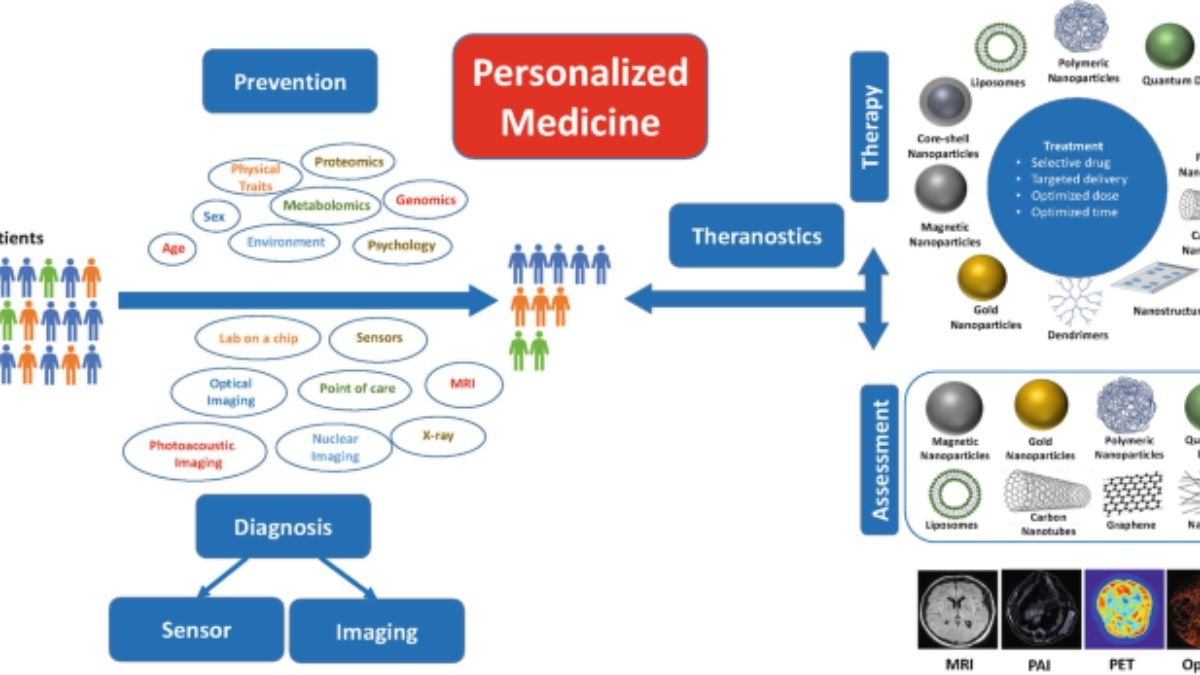Health science has undergone many revolutionary changes over the past few decades, but the most impressive is the development of personalized medicine through nanotechnology. This technology is no longer confined to research laboratories but has become a part of treating people in real life. Nanotechnology has empowered doctors and scientists to develop individual treatments tailored to each individual’s body, genes, and disease.
What is nanotechnology?
Nanotechnology is a branch of science that enables the manipulation of matter at the atomic and molecular level. It involves making materials as small as a nanometer (one billionth of a meter). At this microscopic level, when scientists design drugs, devices, and biological structures, their effects on the human body are highly precise and controlled.
For example, formulating a drug as nanoparticles allows it to reach diseased cells directly, enhancing its effectiveness and significantly reducing side effects.
The Concept of Personalized Medicine
Personalized medicine is a medical approach that tailors treatment to each patient’s genes, lifestyle, and physical condition. This differs from traditional medicine, where everyone was given the same medication for the same disease. Doctors now analyze a person’s genome to determine which genes are active or inactive, and then determine which medication, in what dosage, and how often.
Nanotechnology makes this personalized treatment more effective and safe by allowing drugs and treatments to be delivered directly to the target area.
The Combination of Nanotechnology and Personalized Medicine
Nanotechnology has revolutionized medicine because it works at the cell and DNA level. When a person’s body structure is studied in detail, it is easier to understand where and how disease is progressing.
Nanobots, or microscopic robots made from nanotechnology, are now being experimentally studied to penetrate the body and repair diseased cells. Similarly, nanoparticles deliver drugs to targeted cells. This means that in personalized medicine, nanotechnology is the bridge connecting science and individualized treatment.
The Role of Nanotechnology in Cancer Treatment
Cancer is a disease in which cells begin to grow out of control. Traditional treatments like chemotherapy affect the entire body, causing significant side effects. However, with the help of nanotechnology, cancer treatment is now being transformed into targeted therapy.
Nanoparticles are designed to recognize and release the drug only at cancer cells. This not only reduces the amount of drug used but also protects healthy cells. This approach can vary depending on each patient’s body and the nature of the cancer—this is the fundamental objective of personalized medicine.
The Role of Nanotech in Early Disease Detection
Nanotechnology isn’t limited to treatment; it’s also playing a significant role in disease diagnosis. Nanosensors and nanobiomarkers have become tools that can detect even the most subtle changes.
For example, if a person’s blood contains very low levels of cancer cells or signs of infection, traditional tests may not detect them. However, nanotechnology-based sensors can provide this information much earlier, allowing treatment to begin at an early stage of the disease.
Thus, nanotechnology has shifted medical diagnostics from “reactive” to “preventive.”
The Combination of Nanotech and Gene Therapy
Gene therapy is considered the future hope in medical science. It involves correcting or replacing defective genes in a person’s DNA. Nanotechnology has made this process safer and more precise.
Nanoparticles are used to safely deliver genes into the body’s cells. This ensures that the treatment reaches only the target cells, greatly reducing the likelihood of unwanted effects.
This combination of genes and nanotech could revolutionize the treatment of genetic diseases such as cystic fibrosis, hemophilia, and even some mental disorders in the coming years.
Precise Delivery of Drugs Using Nanotechnology
The biggest problem with traditional drugs is that they spread throughout the body and often reach the target organ in small quantities. This necessitates increased dosages, which also increases the risk of side effects.
Nanotechnology has solved this challenge. Nanodrug delivery systems are now designed to deliver the drug directly to diseased cells. This approach increases the efficacy of the drug and makes treatment personalized.
The Future of Nanotechnology-Based Medicine
The combination of nanotechnology and personalized medicine is still in its infancy, but its possibilities are endless.
Conclusion
Nanotechnology has opened the door to a unique treatment for every individual. The concept of “one size fits all” is gradually disappearing, giving way to the idea of ”different solutions for each individual.”
This combination of personalized medicine and nanotechnology will make healthcare more precise, effective, and human-centered in the coming years. It will not only provide better treatment for diseases but also give people greater control over their health than ever before.
